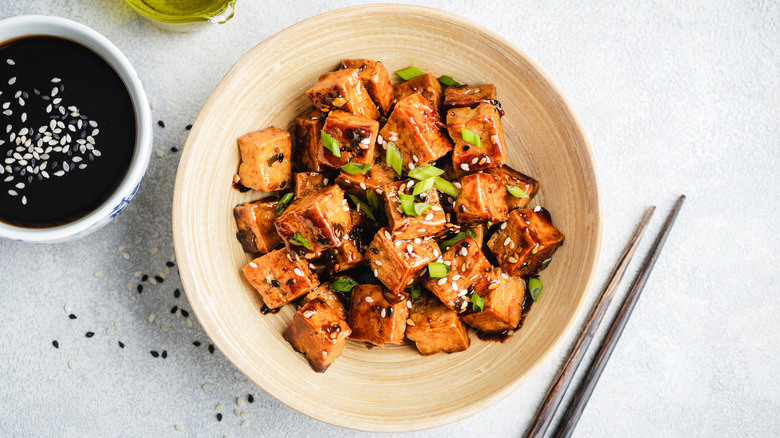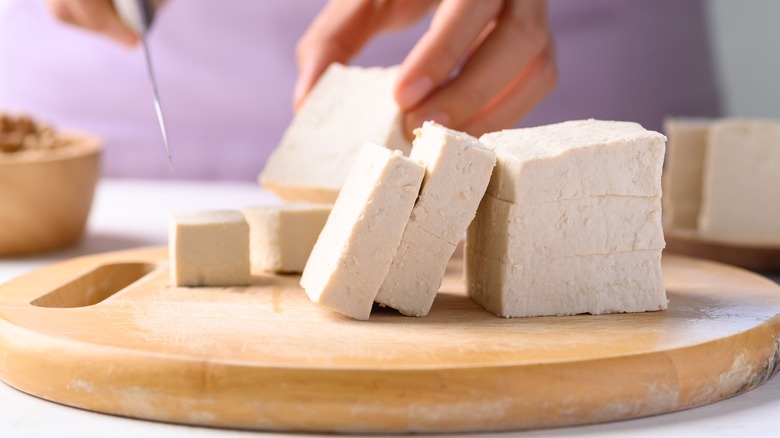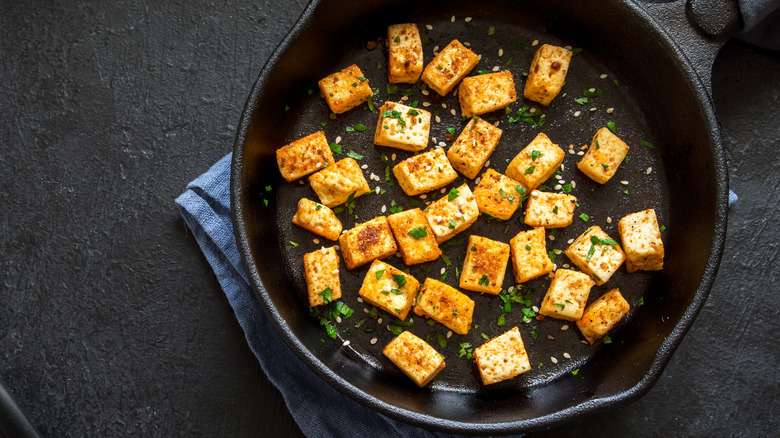Sometimes You Really Shouldn't Be Pressing Tofu (Here's What To Do Instead)
With long-standing roots in China and used widely in many Asian cuisines, tofu is enjoyed as an alternative to meat and is known for its spongy, porous nature, which provides a chewy bite and helps absorb flavors, marinades, and sauces added to the dish.
For optimal texture in cooking, many recipes, like air fryer coconut tofu, call for using a commercial tofu press or placing tofu on a paper towel and weighing it down with various objects, to drain it for at least 30 minutes before cutting it into cubes. However in manufacturing tofu, soybeans are soaked and ground to form soy milk, which then is coagulated into curds and separated from the liquid whey. Depending on the style, tofu blocks are commonly already pressed to various degrees in the manufacturing facility to result in several varieties of firmness, including firm and extra-firm tofu (while silken and soft varieties are not pressed).
If you buy firm or extra-firm tofu varieties, you can skip the wait and time it takes to press tofu, as it's already been pressed in the factory. Additionally, pressing tofu at home also could remove too much of the good moisture, resulting in tofu that's too crumbly and dry. Instead, simply blot off the excess moisture, freeze the block, or coat tofu cubes in starch prior to cooking to avoid moisture from seeping out during various cooking methods.
How to remove excess moisture from tofu
The purpose of traditional pressing methods when preparing tofu is to remove excess moisture so that your final baked, grilled, or fried tofu cubes are crispy and firm on the outside and have a soft, spongy chew on the interior. When using firm or extra firm tofu, you can take a few measures to ensure there's not a lot of liquid on the exterior of the cubes prior to cooking.
Most of the time, tofu is retailed in vacuum-sealed packages that contain liquid. When preparing tofu, first open and drain the extra liquid completely from the container, then remove the block and gently blot it down all sides of the tofu with a paper towel or cheesecloth. Once you've done so and removed any excess moisture droplets on the outside of the block, cut the tofu into cubes, strips, or even large tofu steaks. When deep-frying or pan-frying tofu, blot the tofu dry, cut as desired, and toss it in a light coating of flour or food starch as a barrier to keep the moisture in when it enters the hot oil.
If you have extra time, another option is to drain the liquid from the container, remove the tofu and wrap it in plastic wrap and freeze the block prior to cutting it. This will firm up the tofu, and once thawed, the tofu will have a spongier texture while retaining its natural moisture.
Achieving the right texture
Making tofu is all about a fine balance of textures. After you've blotted the tofu to dry, it's important to avoid introducing any extra moisture before and during cooking. This means when preparing dishes such as homemade vegan tofu stir-fry, you'll want to coat the tofu cubes in starch and pan-fry them in a wok or pan with oil prior to adding in other ingredients, including the veggies and liquid marinades. This allows the tofu to crisp up on the outside and keep its soft texture inside. It also reduces the chances of the tofu becoming too wet and delicate, causing it to break.
To bake tofu in the oven, top it with some salt to capture any excess liquid on the surface of the cubes. Keep it in the oven for enough time to crisp up the outer edges (for about 30 minutes, baked at 400 degrees Fahrenheit).
Whatever way you cook it, it's important to make sure you buy the firm or extra firm stuff if you are going to skip the press, and mostly avoid cooking with soft and silken tofu varieties, as those typically haven't been pre-pressed and are best used for imparting smooth texture in baking vegan cheesecakes and puddings, or as a nutritious textural boost when blended in smoothies.


